Reward Management: Strategies, Policies, Practices & PwC Analysis
VerifiedAdded on 2023/06/11
|19
|5531
|331
Report
AI Summary
This report provides a comprehensive overview of reward management, exploring the internal and external factors influencing reward systems, including pay structures, agency theory, equity theory, and the law of supply and demand. It delves into the significance of pay, efficiency wages, and methods for gathering reward intelligence, such as exit interviews and attitude surveys. The report also examines the role of business drivers like alignment, efficiency, scalability, and productivity in shaping reward processes. Furthermore, it discusses key reward principles, emphasizing fairness, consistency, transparency, and equity, and differentiates between intrinsic and extrinsic rewards. The implementation of reward strategies at PwC is analyzed, highlighting the design, implementation, management, and support phases, as well as the crucial contribution of line managers in reward decision-making, ultimately emphasizing the importance of a well-designed reward system for improving employee contribution and organizational performance. The document is available on Desklib, a platform offering a variety of study resources for students.
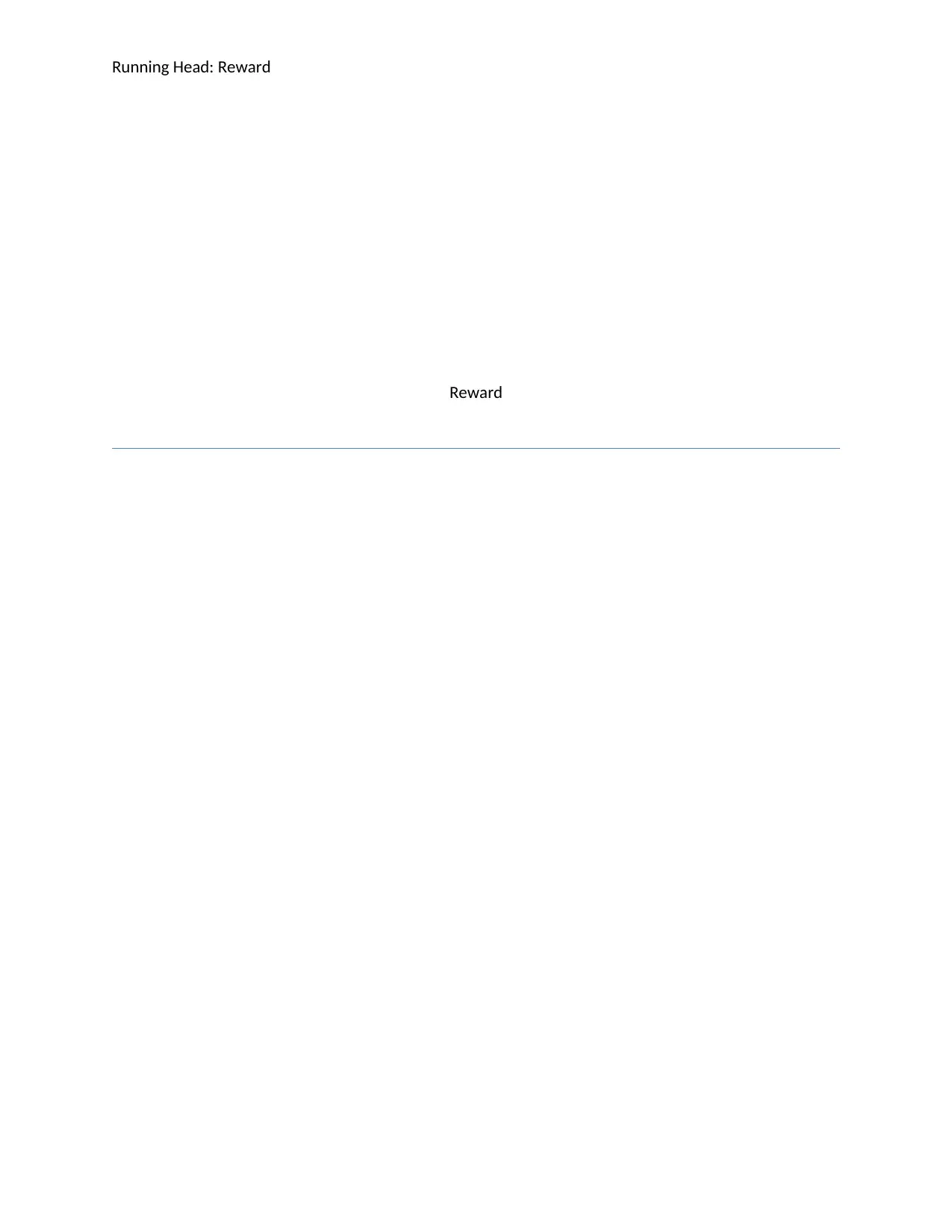
Running Head: Reward
Reward
Reward
Paraphrase This Document
Need a fresh take? Get an instant paraphrase of this document with our AI Paraphraser
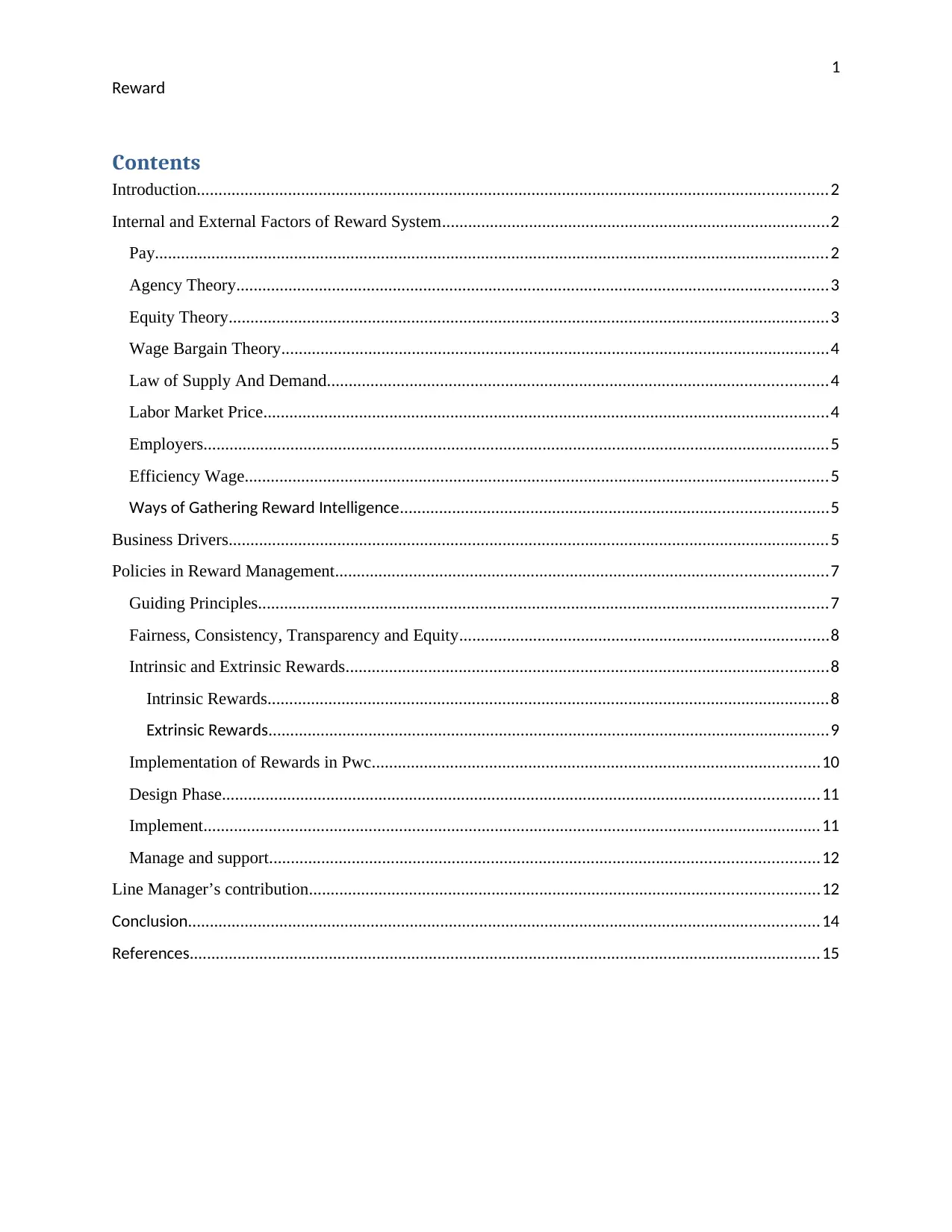
1
Reward
Contents
Introduction.................................................................................................................................................2
Internal and External Factors of Reward System.........................................................................................2
Pay...........................................................................................................................................................2
Agency Theory........................................................................................................................................3
Equity Theory..........................................................................................................................................3
Wage Bargain Theory..............................................................................................................................4
Law of Supply And Demand...................................................................................................................4
Labor Market Price..................................................................................................................................4
Employers................................................................................................................................................5
Efficiency Wage......................................................................................................................................5
Ways of Gathering Reward Intelligence..................................................................................................5
Business Drivers..........................................................................................................................................5
Policies in Reward Management.................................................................................................................7
Guiding Principles...................................................................................................................................7
Fairness, Consistency, Transparency and Equity.....................................................................................8
Intrinsic and Extrinsic Rewards...............................................................................................................8
Intrinsic Rewards.................................................................................................................................8
Extrinsic Rewards.................................................................................................................................9
Implementation of Rewards in Pwc.......................................................................................................10
Design Phase.........................................................................................................................................11
Implement..............................................................................................................................................11
Manage and support..............................................................................................................................12
Line Manager’s contribution.....................................................................................................................12
Conclusion.................................................................................................................................................14
References.................................................................................................................................................15
Reward
Contents
Introduction.................................................................................................................................................2
Internal and External Factors of Reward System.........................................................................................2
Pay...........................................................................................................................................................2
Agency Theory........................................................................................................................................3
Equity Theory..........................................................................................................................................3
Wage Bargain Theory..............................................................................................................................4
Law of Supply And Demand...................................................................................................................4
Labor Market Price..................................................................................................................................4
Employers................................................................................................................................................5
Efficiency Wage......................................................................................................................................5
Ways of Gathering Reward Intelligence..................................................................................................5
Business Drivers..........................................................................................................................................5
Policies in Reward Management.................................................................................................................7
Guiding Principles...................................................................................................................................7
Fairness, Consistency, Transparency and Equity.....................................................................................8
Intrinsic and Extrinsic Rewards...............................................................................................................8
Intrinsic Rewards.................................................................................................................................8
Extrinsic Rewards.................................................................................................................................9
Implementation of Rewards in Pwc.......................................................................................................10
Design Phase.........................................................................................................................................11
Implement..............................................................................................................................................11
Manage and support..............................................................................................................................12
Line Manager’s contribution.....................................................................................................................12
Conclusion.................................................................................................................................................14
References.................................................................................................................................................15
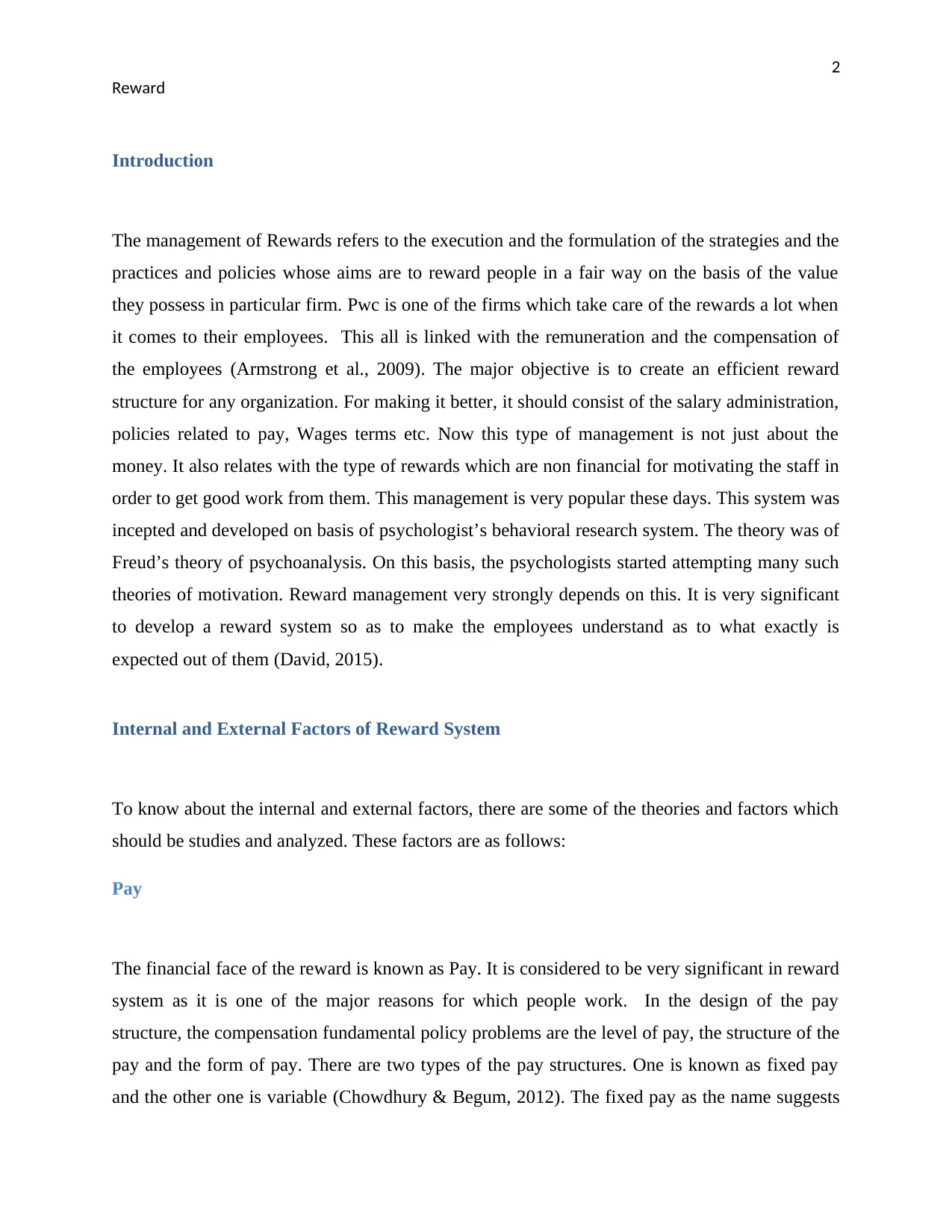
2
Reward
Introduction
The management of Rewards refers to the execution and the formulation of the strategies and the
practices and policies whose aims are to reward people in a fair way on the basis of the value
they possess in particular firm. Pwc is one of the firms which take care of the rewards a lot when
it comes to their employees. This all is linked with the remuneration and the compensation of
the employees (Armstrong et al., 2009). The major objective is to create an efficient reward
structure for any organization. For making it better, it should consist of the salary administration,
policies related to pay, Wages terms etc. Now this type of management is not just about the
money. It also relates with the type of rewards which are non financial for motivating the staff in
order to get good work from them. This management is very popular these days. This system was
incepted and developed on basis of psychologist’s behavioral research system. The theory was of
Freud’s theory of psychoanalysis. On this basis, the psychologists started attempting many such
theories of motivation. Reward management very strongly depends on this. It is very significant
to develop a reward system so as to make the employees understand as to what exactly is
expected out of them (David, 2015).
Internal and External Factors of Reward System
To know about the internal and external factors, there are some of the theories and factors which
should be studies and analyzed. These factors are as follows:
Pay
The financial face of the reward is known as Pay. It is considered to be very significant in reward
system as it is one of the major reasons for which people work. In the design of the pay
structure, the compensation fundamental policy problems are the level of pay, the structure of the
pay and the form of pay. There are two types of the pay structures. One is known as fixed pay
and the other one is variable (Chowdhury & Begum, 2012). The fixed pay as the name suggests
Reward
Introduction
The management of Rewards refers to the execution and the formulation of the strategies and the
practices and policies whose aims are to reward people in a fair way on the basis of the value
they possess in particular firm. Pwc is one of the firms which take care of the rewards a lot when
it comes to their employees. This all is linked with the remuneration and the compensation of
the employees (Armstrong et al., 2009). The major objective is to create an efficient reward
structure for any organization. For making it better, it should consist of the salary administration,
policies related to pay, Wages terms etc. Now this type of management is not just about the
money. It also relates with the type of rewards which are non financial for motivating the staff in
order to get good work from them. This management is very popular these days. This system was
incepted and developed on basis of psychologist’s behavioral research system. The theory was of
Freud’s theory of psychoanalysis. On this basis, the psychologists started attempting many such
theories of motivation. Reward management very strongly depends on this. It is very significant
to develop a reward system so as to make the employees understand as to what exactly is
expected out of them (David, 2015).
Internal and External Factors of Reward System
To know about the internal and external factors, there are some of the theories and factors which
should be studies and analyzed. These factors are as follows:
Pay
The financial face of the reward is known as Pay. It is considered to be very significant in reward
system as it is one of the major reasons for which people work. In the design of the pay
structure, the compensation fundamental policy problems are the level of pay, the structure of the
pay and the form of pay. There are two types of the pay structures. One is known as fixed pay
and the other one is variable (Chowdhury & Begum, 2012). The fixed pay as the name suggests
⊘ This is a preview!⊘
Do you want full access?
Subscribe today to unlock all pages.

Trusted by 1+ million students worldwide
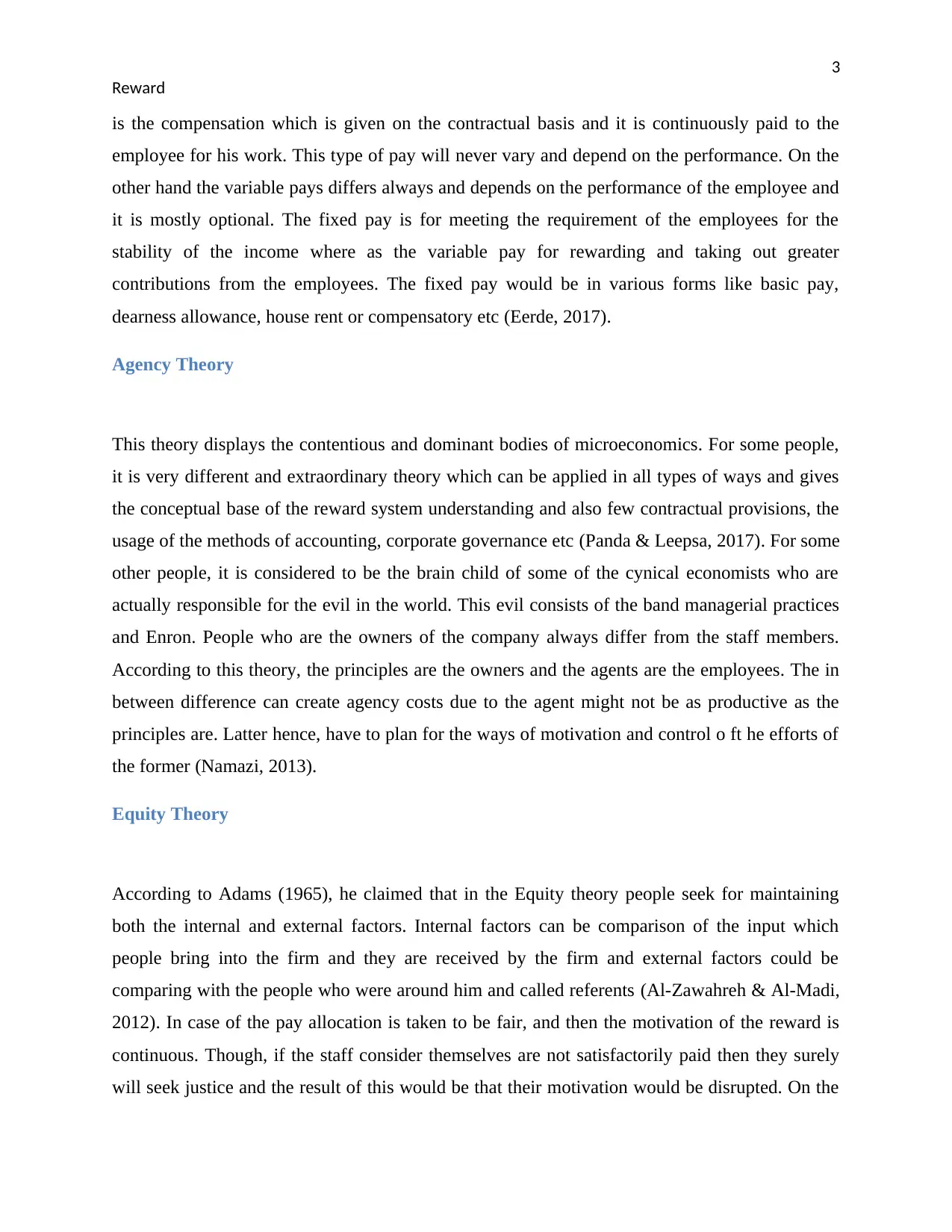
3
Reward
is the compensation which is given on the contractual basis and it is continuously paid to the
employee for his work. This type of pay will never vary and depend on the performance. On the
other hand the variable pays differs always and depends on the performance of the employee and
it is mostly optional. The fixed pay is for meeting the requirement of the employees for the
stability of the income where as the variable pay for rewarding and taking out greater
contributions from the employees. The fixed pay would be in various forms like basic pay,
dearness allowance, house rent or compensatory etc (Eerde, 2017).
Agency Theory
This theory displays the contentious and dominant bodies of microeconomics. For some people,
it is very different and extraordinary theory which can be applied in all types of ways and gives
the conceptual base of the reward system understanding and also few contractual provisions, the
usage of the methods of accounting, corporate governance etc (Panda & Leepsa, 2017). For some
other people, it is considered to be the brain child of some of the cynical economists who are
actually responsible for the evil in the world. This evil consists of the band managerial practices
and Enron. People who are the owners of the company always differ from the staff members.
According to this theory, the principles are the owners and the agents are the employees. The in
between difference can create agency costs due to the agent might not be as productive as the
principles are. Latter hence, have to plan for the ways of motivation and control o ft he efforts of
the former (Namazi, 2013).
Equity Theory
According to Adams (1965), he claimed that in the Equity theory people seek for maintaining
both the internal and external factors. Internal factors can be comparison of the input which
people bring into the firm and they are received by the firm and external factors could be
comparing with the people who were around him and called referents (Al-Zawahreh & Al-Madi,
2012). In case of the pay allocation is taken to be fair, and then the motivation of the reward is
continuous. Though, if the staff consider themselves are not satisfactorily paid then they surely
will seek justice and the result of this would be that their motivation would be disrupted. On the
Reward
is the compensation which is given on the contractual basis and it is continuously paid to the
employee for his work. This type of pay will never vary and depend on the performance. On the
other hand the variable pays differs always and depends on the performance of the employee and
it is mostly optional. The fixed pay is for meeting the requirement of the employees for the
stability of the income where as the variable pay for rewarding and taking out greater
contributions from the employees. The fixed pay would be in various forms like basic pay,
dearness allowance, house rent or compensatory etc (Eerde, 2017).
Agency Theory
This theory displays the contentious and dominant bodies of microeconomics. For some people,
it is very different and extraordinary theory which can be applied in all types of ways and gives
the conceptual base of the reward system understanding and also few contractual provisions, the
usage of the methods of accounting, corporate governance etc (Panda & Leepsa, 2017). For some
other people, it is considered to be the brain child of some of the cynical economists who are
actually responsible for the evil in the world. This evil consists of the band managerial practices
and Enron. People who are the owners of the company always differ from the staff members.
According to this theory, the principles are the owners and the agents are the employees. The in
between difference can create agency costs due to the agent might not be as productive as the
principles are. Latter hence, have to plan for the ways of motivation and control o ft he efforts of
the former (Namazi, 2013).
Equity Theory
According to Adams (1965), he claimed that in the Equity theory people seek for maintaining
both the internal and external factors. Internal factors can be comparison of the input which
people bring into the firm and they are received by the firm and external factors could be
comparing with the people who were around him and called referents (Al-Zawahreh & Al-Madi,
2012). In case of the pay allocation is taken to be fair, and then the motivation of the reward is
continuous. Though, if the staff consider themselves are not satisfactorily paid then they surely
will seek justice and the result of this would be that their motivation would be disrupted. On the
Paraphrase This Document
Need a fresh take? Get an instant paraphrase of this document with our AI Paraphraser
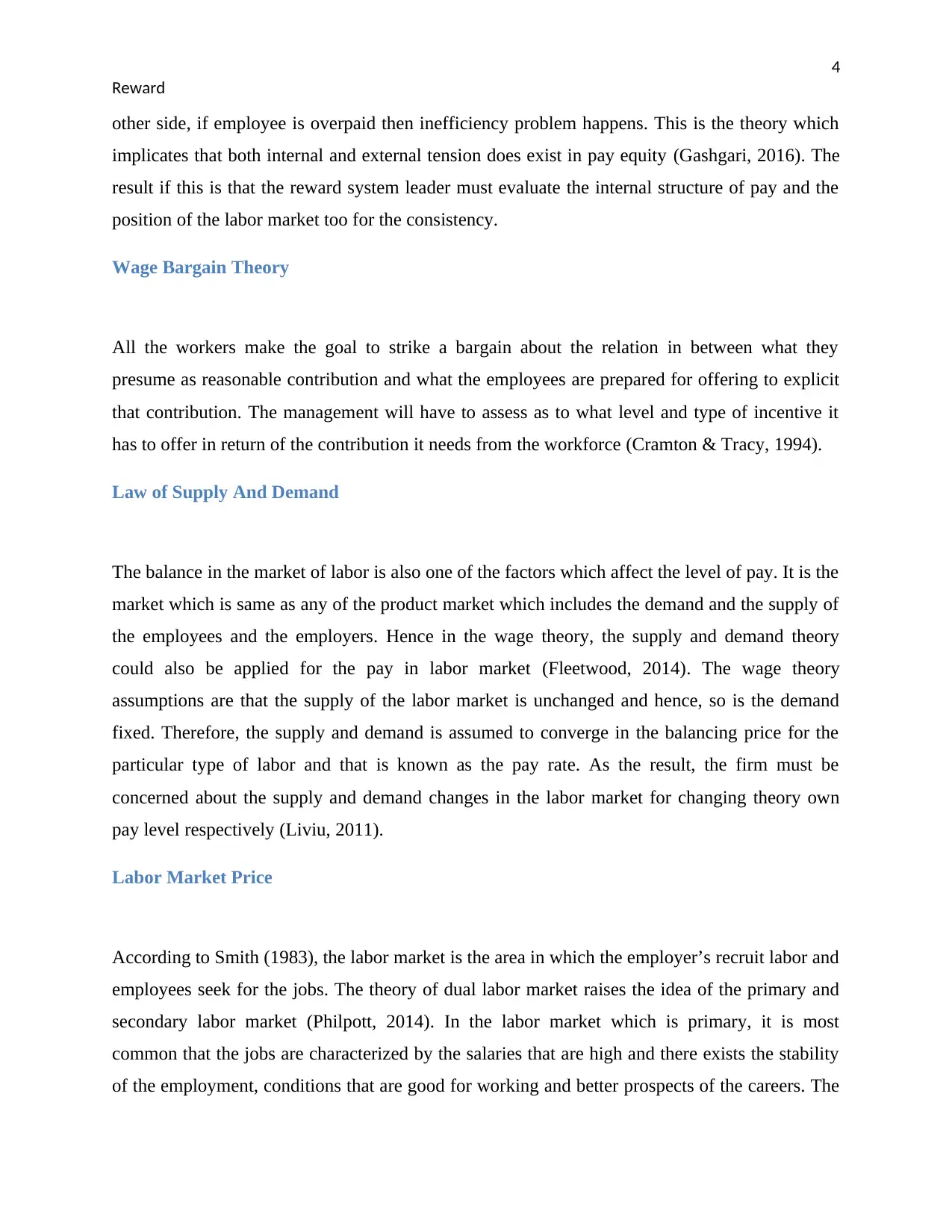
4
Reward
other side, if employee is overpaid then inefficiency problem happens. This is the theory which
implicates that both internal and external tension does exist in pay equity (Gashgari, 2016). The
result if this is that the reward system leader must evaluate the internal structure of pay and the
position of the labor market too for the consistency.
Wage Bargain Theory
All the workers make the goal to strike a bargain about the relation in between what they
presume as reasonable contribution and what the employees are prepared for offering to explicit
that contribution. The management will have to assess as to what level and type of incentive it
has to offer in return of the contribution it needs from the workforce (Cramton & Tracy, 1994).
Law of Supply And Demand
The balance in the market of labor is also one of the factors which affect the level of pay. It is the
market which is same as any of the product market which includes the demand and the supply of
the employees and the employers. Hence in the wage theory, the supply and demand theory
could also be applied for the pay in labor market (Fleetwood, 2014). The wage theory
assumptions are that the supply of the labor market is unchanged and hence, so is the demand
fixed. Therefore, the supply and demand is assumed to converge in the balancing price for the
particular type of labor and that is known as the pay rate. As the result, the firm must be
concerned about the supply and demand changes in the labor market for changing theory own
pay level respectively (Liviu, 2011).
Labor Market Price
According to Smith (1983), the labor market is the area in which the employer’s recruit labor and
employees seek for the jobs. The theory of dual labor market raises the idea of the primary and
secondary labor market (Philpott, 2014). In the labor market which is primary, it is most
common that the jobs are characterized by the salaries that are high and there exists the stability
of the employment, conditions that are good for working and better prospects of the careers. The
Reward
other side, if employee is overpaid then inefficiency problem happens. This is the theory which
implicates that both internal and external tension does exist in pay equity (Gashgari, 2016). The
result if this is that the reward system leader must evaluate the internal structure of pay and the
position of the labor market too for the consistency.
Wage Bargain Theory
All the workers make the goal to strike a bargain about the relation in between what they
presume as reasonable contribution and what the employees are prepared for offering to explicit
that contribution. The management will have to assess as to what level and type of incentive it
has to offer in return of the contribution it needs from the workforce (Cramton & Tracy, 1994).
Law of Supply And Demand
The balance in the market of labor is also one of the factors which affect the level of pay. It is the
market which is same as any of the product market which includes the demand and the supply of
the employees and the employers. Hence in the wage theory, the supply and demand theory
could also be applied for the pay in labor market (Fleetwood, 2014). The wage theory
assumptions are that the supply of the labor market is unchanged and hence, so is the demand
fixed. Therefore, the supply and demand is assumed to converge in the balancing price for the
particular type of labor and that is known as the pay rate. As the result, the firm must be
concerned about the supply and demand changes in the labor market for changing theory own
pay level respectively (Liviu, 2011).
Labor Market Price
According to Smith (1983), the labor market is the area in which the employer’s recruit labor and
employees seek for the jobs. The theory of dual labor market raises the idea of the primary and
secondary labor market (Philpott, 2014). In the labor market which is primary, it is most
common that the jobs are characterized by the salaries that are high and there exists the stability
of the employment, conditions that are good for working and better prospects of the careers. The
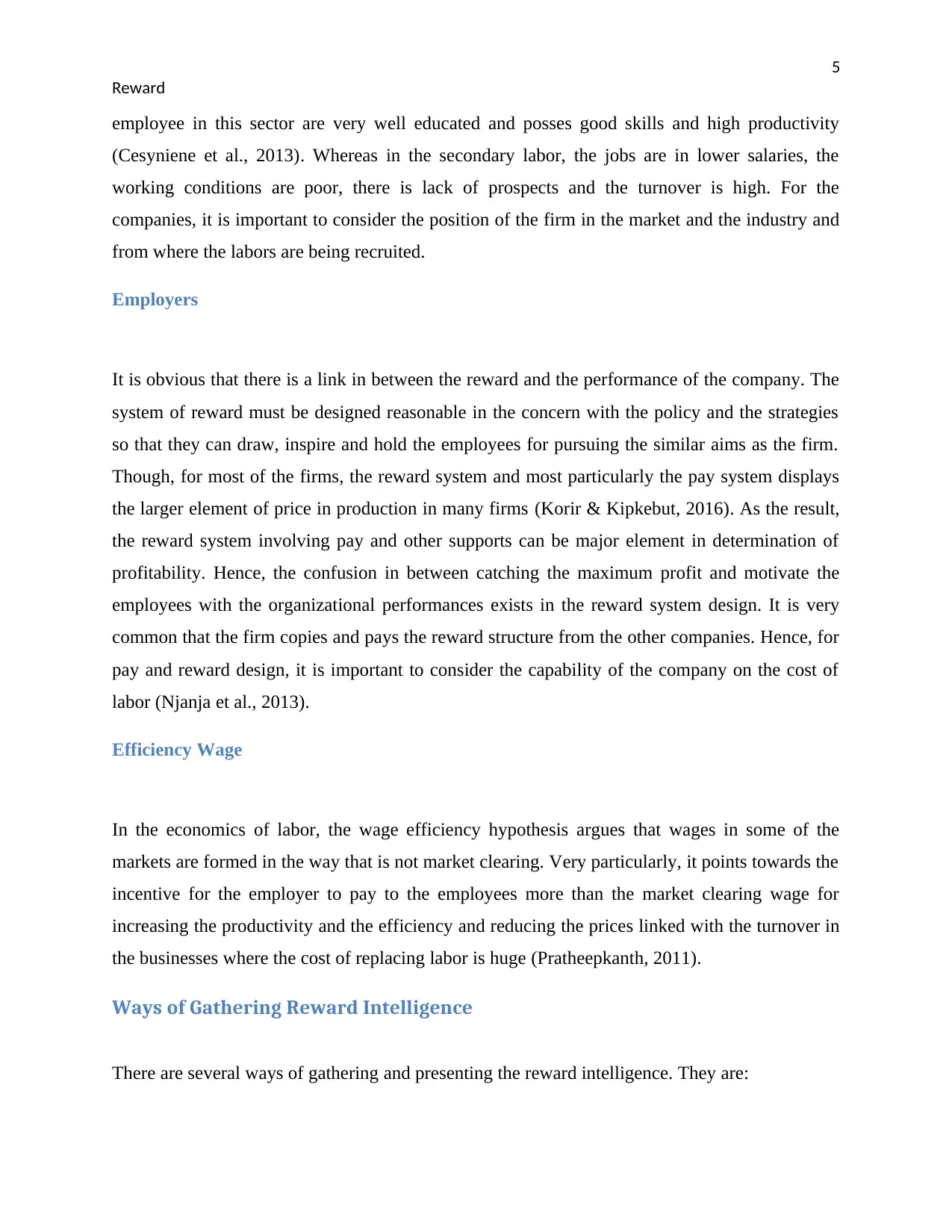
5
Reward
employee in this sector are very well educated and posses good skills and high productivity
(Cesyniene et al., 2013). Whereas in the secondary labor, the jobs are in lower salaries, the
working conditions are poor, there is lack of prospects and the turnover is high. For the
companies, it is important to consider the position of the firm in the market and the industry and
from where the labors are being recruited.
Employers
It is obvious that there is a link in between the reward and the performance of the company. The
system of reward must be designed reasonable in the concern with the policy and the strategies
so that they can draw, inspire and hold the employees for pursuing the similar aims as the firm.
Though, for most of the firms, the reward system and most particularly the pay system displays
the larger element of price in production in many firms (Korir & Kipkebut, 2016). As the result,
the reward system involving pay and other supports can be major element in determination of
profitability. Hence, the confusion in between catching the maximum profit and motivate the
employees with the organizational performances exists in the reward system design. It is very
common that the firm copies and pays the reward structure from the other companies. Hence, for
pay and reward design, it is important to consider the capability of the company on the cost of
labor (Njanja et al., 2013).
Efficiency Wage
In the economics of labor, the wage efficiency hypothesis argues that wages in some of the
markets are formed in the way that is not market clearing. Very particularly, it points towards the
incentive for the employer to pay to the employees more than the market clearing wage for
increasing the productivity and the efficiency and reducing the prices linked with the turnover in
the businesses where the cost of replacing labor is huge (Pratheepkanth, 2011).
Ways of Gathering Reward Intelligence
There are several ways of gathering and presenting the reward intelligence. They are:
Reward
employee in this sector are very well educated and posses good skills and high productivity
(Cesyniene et al., 2013). Whereas in the secondary labor, the jobs are in lower salaries, the
working conditions are poor, there is lack of prospects and the turnover is high. For the
companies, it is important to consider the position of the firm in the market and the industry and
from where the labors are being recruited.
Employers
It is obvious that there is a link in between the reward and the performance of the company. The
system of reward must be designed reasonable in the concern with the policy and the strategies
so that they can draw, inspire and hold the employees for pursuing the similar aims as the firm.
Though, for most of the firms, the reward system and most particularly the pay system displays
the larger element of price in production in many firms (Korir & Kipkebut, 2016). As the result,
the reward system involving pay and other supports can be major element in determination of
profitability. Hence, the confusion in between catching the maximum profit and motivate the
employees with the organizational performances exists in the reward system design. It is very
common that the firm copies and pays the reward structure from the other companies. Hence, for
pay and reward design, it is important to consider the capability of the company on the cost of
labor (Njanja et al., 2013).
Efficiency Wage
In the economics of labor, the wage efficiency hypothesis argues that wages in some of the
markets are formed in the way that is not market clearing. Very particularly, it points towards the
incentive for the employer to pay to the employees more than the market clearing wage for
increasing the productivity and the efficiency and reducing the prices linked with the turnover in
the businesses where the cost of replacing labor is huge (Pratheepkanth, 2011).
Ways of Gathering Reward Intelligence
There are several ways of gathering and presenting the reward intelligence. They are:
⊘ This is a preview!⊘
Do you want full access?
Subscribe today to unlock all pages.

Trusted by 1+ million students worldwide
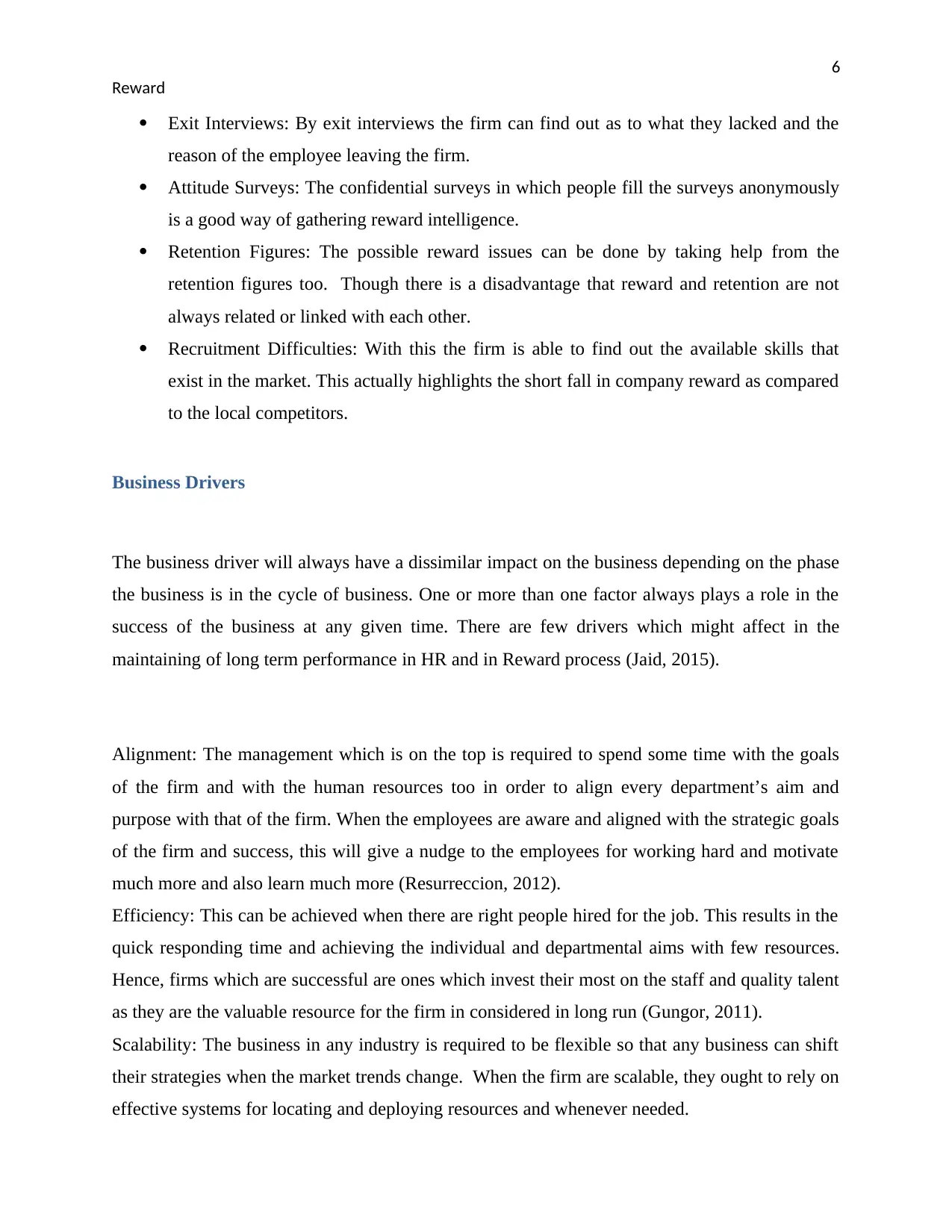
6
Reward
Exit Interviews: By exit interviews the firm can find out as to what they lacked and the
reason of the employee leaving the firm.
Attitude Surveys: The confidential surveys in which people fill the surveys anonymously
is a good way of gathering reward intelligence.
Retention Figures: The possible reward issues can be done by taking help from the
retention figures too. Though there is a disadvantage that reward and retention are not
always related or linked with each other.
Recruitment Difficulties: With this the firm is able to find out the available skills that
exist in the market. This actually highlights the short fall in company reward as compared
to the local competitors.
Business Drivers
The business driver will always have a dissimilar impact on the business depending on the phase
the business is in the cycle of business. One or more than one factor always plays a role in the
success of the business at any given time. There are few drivers which might affect in the
maintaining of long term performance in HR and in Reward process (Jaid, 2015).
Alignment: The management which is on the top is required to spend some time with the goals
of the firm and with the human resources too in order to align every department’s aim and
purpose with that of the firm. When the employees are aware and aligned with the strategic goals
of the firm and success, this will give a nudge to the employees for working hard and motivate
much more and also learn much more (Resurreccion, 2012).
Efficiency: This can be achieved when there are right people hired for the job. This results in the
quick responding time and achieving the individual and departmental aims with few resources.
Hence, firms which are successful are ones which invest their most on the staff and quality talent
as they are the valuable resource for the firm in considered in long run (Gungor, 2011).
Scalability: The business in any industry is required to be flexible so that any business can shift
their strategies when the market trends change. When the firm are scalable, they ought to rely on
effective systems for locating and deploying resources and whenever needed.
Reward
Exit Interviews: By exit interviews the firm can find out as to what they lacked and the
reason of the employee leaving the firm.
Attitude Surveys: The confidential surveys in which people fill the surveys anonymously
is a good way of gathering reward intelligence.
Retention Figures: The possible reward issues can be done by taking help from the
retention figures too. Though there is a disadvantage that reward and retention are not
always related or linked with each other.
Recruitment Difficulties: With this the firm is able to find out the available skills that
exist in the market. This actually highlights the short fall in company reward as compared
to the local competitors.
Business Drivers
The business driver will always have a dissimilar impact on the business depending on the phase
the business is in the cycle of business. One or more than one factor always plays a role in the
success of the business at any given time. There are few drivers which might affect in the
maintaining of long term performance in HR and in Reward process (Jaid, 2015).
Alignment: The management which is on the top is required to spend some time with the goals
of the firm and with the human resources too in order to align every department’s aim and
purpose with that of the firm. When the employees are aware and aligned with the strategic goals
of the firm and success, this will give a nudge to the employees for working hard and motivate
much more and also learn much more (Resurreccion, 2012).
Efficiency: This can be achieved when there are right people hired for the job. This results in the
quick responding time and achieving the individual and departmental aims with few resources.
Hence, firms which are successful are ones which invest their most on the staff and quality talent
as they are the valuable resource for the firm in considered in long run (Gungor, 2011).
Scalability: The business in any industry is required to be flexible so that any business can shift
their strategies when the market trends change. When the firm are scalable, they ought to rely on
effective systems for locating and deploying resources and whenever needed.
Paraphrase This Document
Need a fresh take? Get an instant paraphrase of this document with our AI Paraphraser
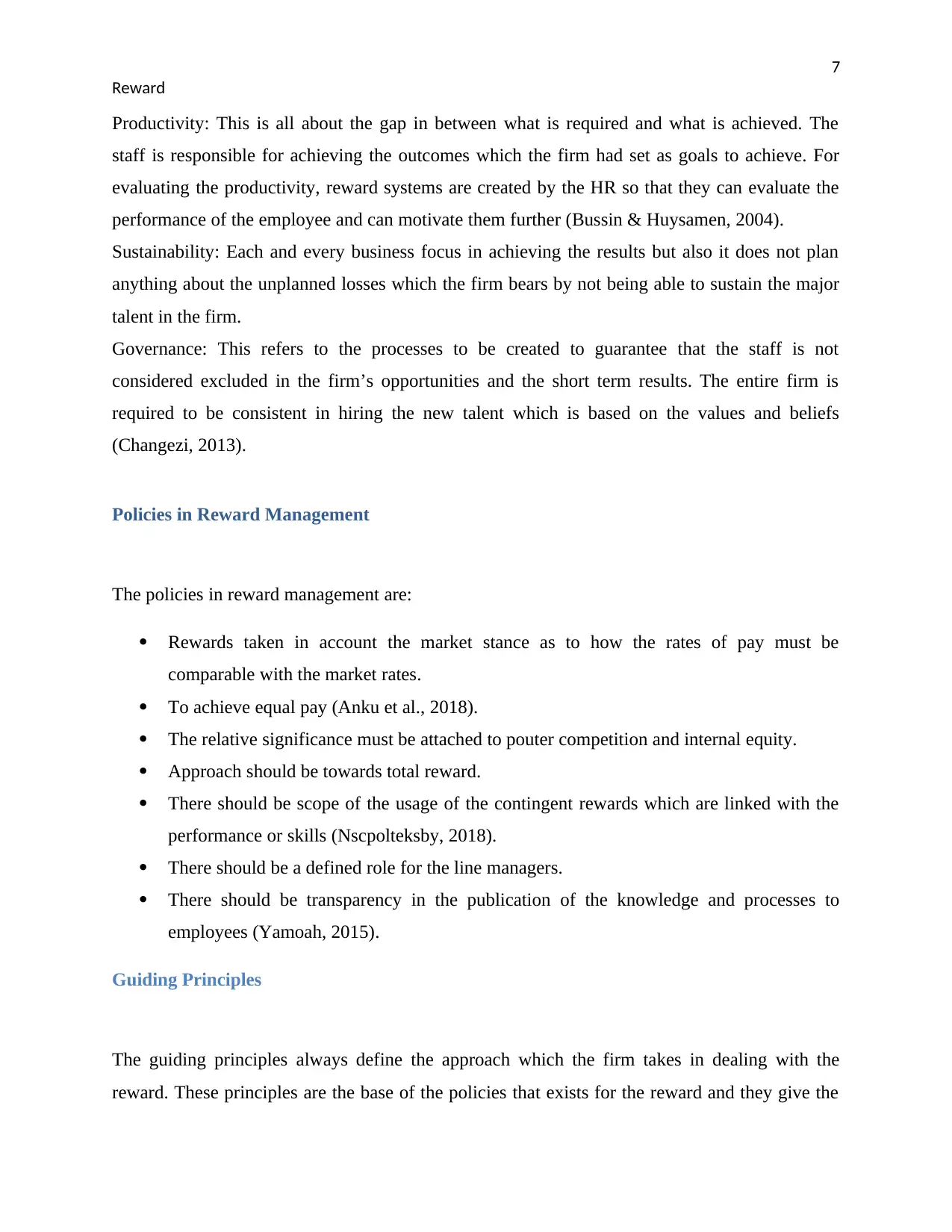
7
Reward
Productivity: This is all about the gap in between what is required and what is achieved. The
staff is responsible for achieving the outcomes which the firm had set as goals to achieve. For
evaluating the productivity, reward systems are created by the HR so that they can evaluate the
performance of the employee and can motivate them further (Bussin & Huysamen, 2004).
Sustainability: Each and every business focus in achieving the results but also it does not plan
anything about the unplanned losses which the firm bears by not being able to sustain the major
talent in the firm.
Governance: This refers to the processes to be created to guarantee that the staff is not
considered excluded in the firm’s opportunities and the short term results. The entire firm is
required to be consistent in hiring the new talent which is based on the values and beliefs
(Changezi, 2013).
Policies in Reward Management
The policies in reward management are:
Rewards taken in account the market stance as to how the rates of pay must be
comparable with the market rates.
To achieve equal pay (Anku et al., 2018).
The relative significance must be attached to pouter competition and internal equity.
Approach should be towards total reward.
There should be scope of the usage of the contingent rewards which are linked with the
performance or skills (Nscpolteksby, 2018).
There should be a defined role for the line managers.
There should be transparency in the publication of the knowledge and processes to
employees (Yamoah, 2015).
Guiding Principles
The guiding principles always define the approach which the firm takes in dealing with the
reward. These principles are the base of the policies that exists for the reward and they give the
Reward
Productivity: This is all about the gap in between what is required and what is achieved. The
staff is responsible for achieving the outcomes which the firm had set as goals to achieve. For
evaluating the productivity, reward systems are created by the HR so that they can evaluate the
performance of the employee and can motivate them further (Bussin & Huysamen, 2004).
Sustainability: Each and every business focus in achieving the results but also it does not plan
anything about the unplanned losses which the firm bears by not being able to sustain the major
talent in the firm.
Governance: This refers to the processes to be created to guarantee that the staff is not
considered excluded in the firm’s opportunities and the short term results. The entire firm is
required to be consistent in hiring the new talent which is based on the values and beliefs
(Changezi, 2013).
Policies in Reward Management
The policies in reward management are:
Rewards taken in account the market stance as to how the rates of pay must be
comparable with the market rates.
To achieve equal pay (Anku et al., 2018).
The relative significance must be attached to pouter competition and internal equity.
Approach should be towards total reward.
There should be scope of the usage of the contingent rewards which are linked with the
performance or skills (Nscpolteksby, 2018).
There should be a defined role for the line managers.
There should be transparency in the publication of the knowledge and processes to
employees (Yamoah, 2015).
Guiding Principles
The guiding principles always define the approach which the firm takes in dealing with the
reward. These principles are the base of the policies that exists for the reward and they give the
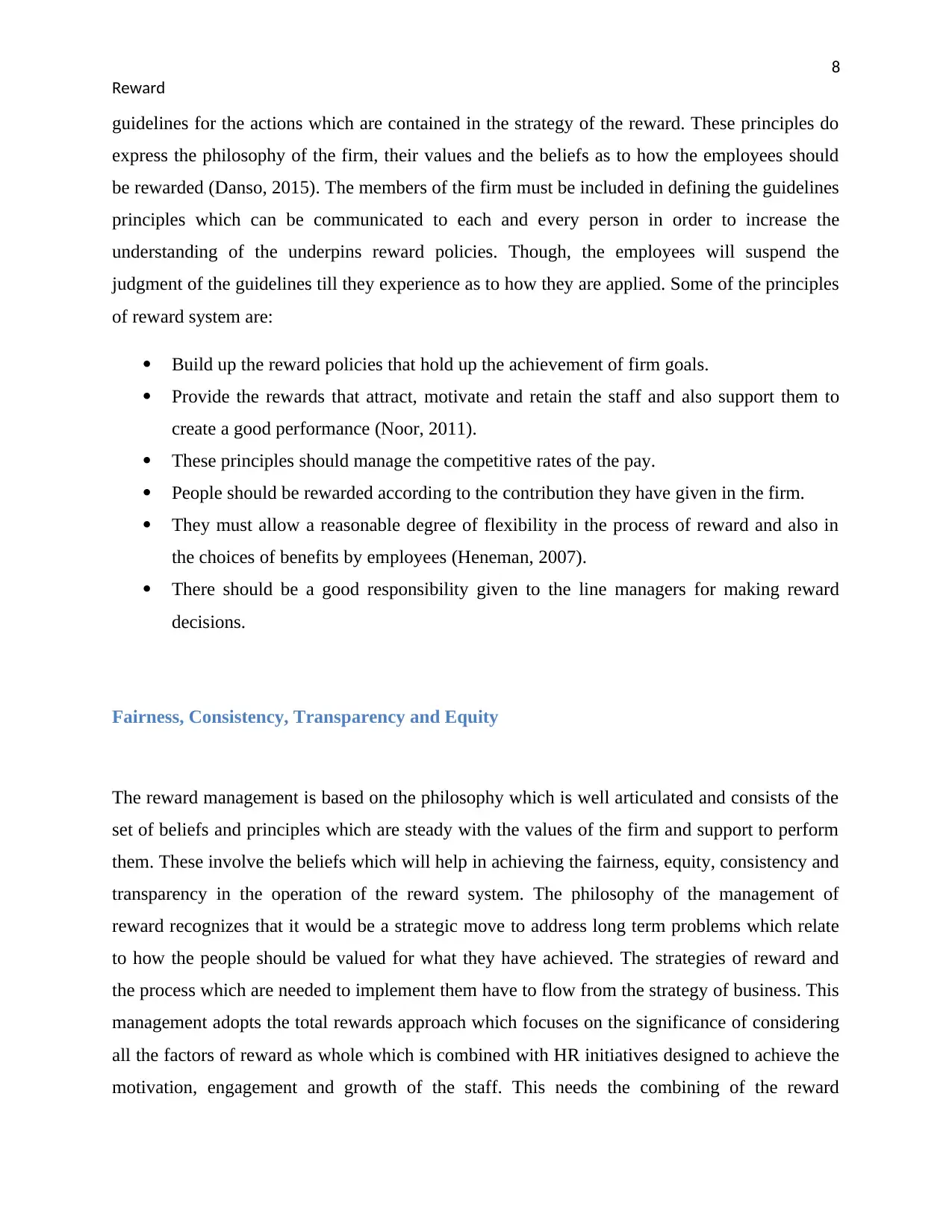
8
Reward
guidelines for the actions which are contained in the strategy of the reward. These principles do
express the philosophy of the firm, their values and the beliefs as to how the employees should
be rewarded (Danso, 2015). The members of the firm must be included in defining the guidelines
principles which can be communicated to each and every person in order to increase the
understanding of the underpins reward policies. Though, the employees will suspend the
judgment of the guidelines till they experience as to how they are applied. Some of the principles
of reward system are:
Build up the reward policies that hold up the achievement of firm goals.
Provide the rewards that attract, motivate and retain the staff and also support them to
create a good performance (Noor, 2011).
These principles should manage the competitive rates of the pay.
People should be rewarded according to the contribution they have given in the firm.
They must allow a reasonable degree of flexibility in the process of reward and also in
the choices of benefits by employees (Heneman, 2007).
There should be a good responsibility given to the line managers for making reward
decisions.
Fairness, Consistency, Transparency and Equity
The reward management is based on the philosophy which is well articulated and consists of the
set of beliefs and principles which are steady with the values of the firm and support to perform
them. These involve the beliefs which will help in achieving the fairness, equity, consistency and
transparency in the operation of the reward system. The philosophy of the management of
reward recognizes that it would be a strategic move to address long term problems which relate
to how the people should be valued for what they have achieved. The strategies of reward and
the process which are needed to implement them have to flow from the strategy of business. This
management adopts the total rewards approach which focuses on the significance of considering
all the factors of reward as whole which is combined with HR initiatives designed to achieve the
motivation, engagement and growth of the staff. This needs the combining of the reward
Reward
guidelines for the actions which are contained in the strategy of the reward. These principles do
express the philosophy of the firm, their values and the beliefs as to how the employees should
be rewarded (Danso, 2015). The members of the firm must be included in defining the guidelines
principles which can be communicated to each and every person in order to increase the
understanding of the underpins reward policies. Though, the employees will suspend the
judgment of the guidelines till they experience as to how they are applied. Some of the principles
of reward system are:
Build up the reward policies that hold up the achievement of firm goals.
Provide the rewards that attract, motivate and retain the staff and also support them to
create a good performance (Noor, 2011).
These principles should manage the competitive rates of the pay.
People should be rewarded according to the contribution they have given in the firm.
They must allow a reasonable degree of flexibility in the process of reward and also in
the choices of benefits by employees (Heneman, 2007).
There should be a good responsibility given to the line managers for making reward
decisions.
Fairness, Consistency, Transparency and Equity
The reward management is based on the philosophy which is well articulated and consists of the
set of beliefs and principles which are steady with the values of the firm and support to perform
them. These involve the beliefs which will help in achieving the fairness, equity, consistency and
transparency in the operation of the reward system. The philosophy of the management of
reward recognizes that it would be a strategic move to address long term problems which relate
to how the people should be valued for what they have achieved. The strategies of reward and
the process which are needed to implement them have to flow from the strategy of business. This
management adopts the total rewards approach which focuses on the significance of considering
all the factors of reward as whole which is combined with HR initiatives designed to achieve the
motivation, engagement and growth of the staff. This needs the combining of the reward
⊘ This is a preview!⊘
Do you want full access?
Subscribe today to unlock all pages.

Trusted by 1+ million students worldwide
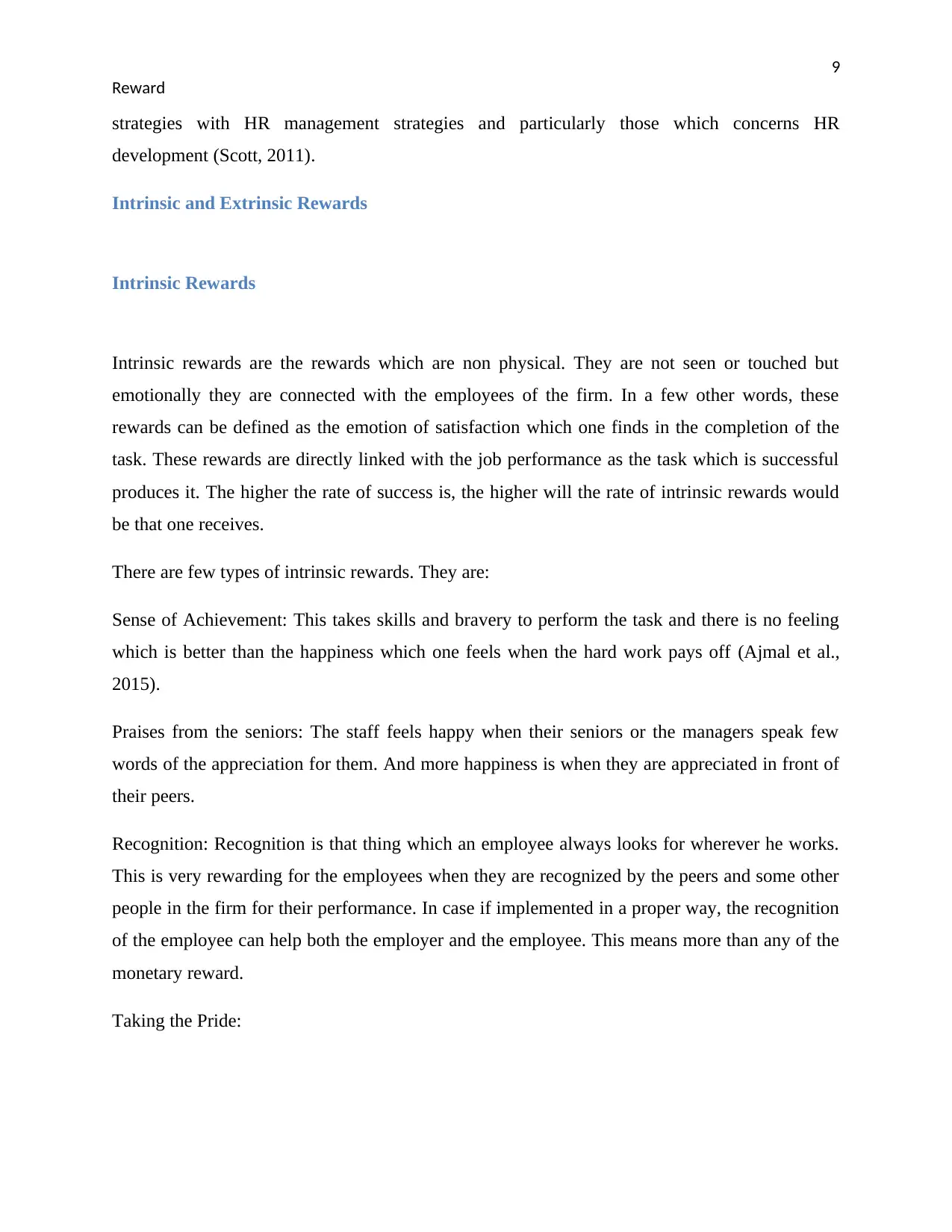
9
Reward
strategies with HR management strategies and particularly those which concerns HR
development (Scott, 2011).
Intrinsic and Extrinsic Rewards
Intrinsic Rewards
Intrinsic rewards are the rewards which are non physical. They are not seen or touched but
emotionally they are connected with the employees of the firm. In a few other words, these
rewards can be defined as the emotion of satisfaction which one finds in the completion of the
task. These rewards are directly linked with the job performance as the task which is successful
produces it. The higher the rate of success is, the higher will the rate of intrinsic rewards would
be that one receives.
There are few types of intrinsic rewards. They are:
Sense of Achievement: This takes skills and bravery to perform the task and there is no feeling
which is better than the happiness which one feels when the hard work pays off (Ajmal et al.,
2015).
Praises from the seniors: The staff feels happy when their seniors or the managers speak few
words of the appreciation for them. And more happiness is when they are appreciated in front of
their peers.
Recognition: Recognition is that thing which an employee always looks for wherever he works.
This is very rewarding for the employees when they are recognized by the peers and some other
people in the firm for their performance. In case if implemented in a proper way, the recognition
of the employee can help both the employer and the employee. This means more than any of the
monetary reward.
Taking the Pride:
Reward
strategies with HR management strategies and particularly those which concerns HR
development (Scott, 2011).
Intrinsic and Extrinsic Rewards
Intrinsic Rewards
Intrinsic rewards are the rewards which are non physical. They are not seen or touched but
emotionally they are connected with the employees of the firm. In a few other words, these
rewards can be defined as the emotion of satisfaction which one finds in the completion of the
task. These rewards are directly linked with the job performance as the task which is successful
produces it. The higher the rate of success is, the higher will the rate of intrinsic rewards would
be that one receives.
There are few types of intrinsic rewards. They are:
Sense of Achievement: This takes skills and bravery to perform the task and there is no feeling
which is better than the happiness which one feels when the hard work pays off (Ajmal et al.,
2015).
Praises from the seniors: The staff feels happy when their seniors or the managers speak few
words of the appreciation for them. And more happiness is when they are appreciated in front of
their peers.
Recognition: Recognition is that thing which an employee always looks for wherever he works.
This is very rewarding for the employees when they are recognized by the peers and some other
people in the firm for their performance. In case if implemented in a proper way, the recognition
of the employee can help both the employer and the employee. This means more than any of the
monetary reward.
Taking the Pride:
Paraphrase This Document
Need a fresh take? Get an instant paraphrase of this document with our AI Paraphraser
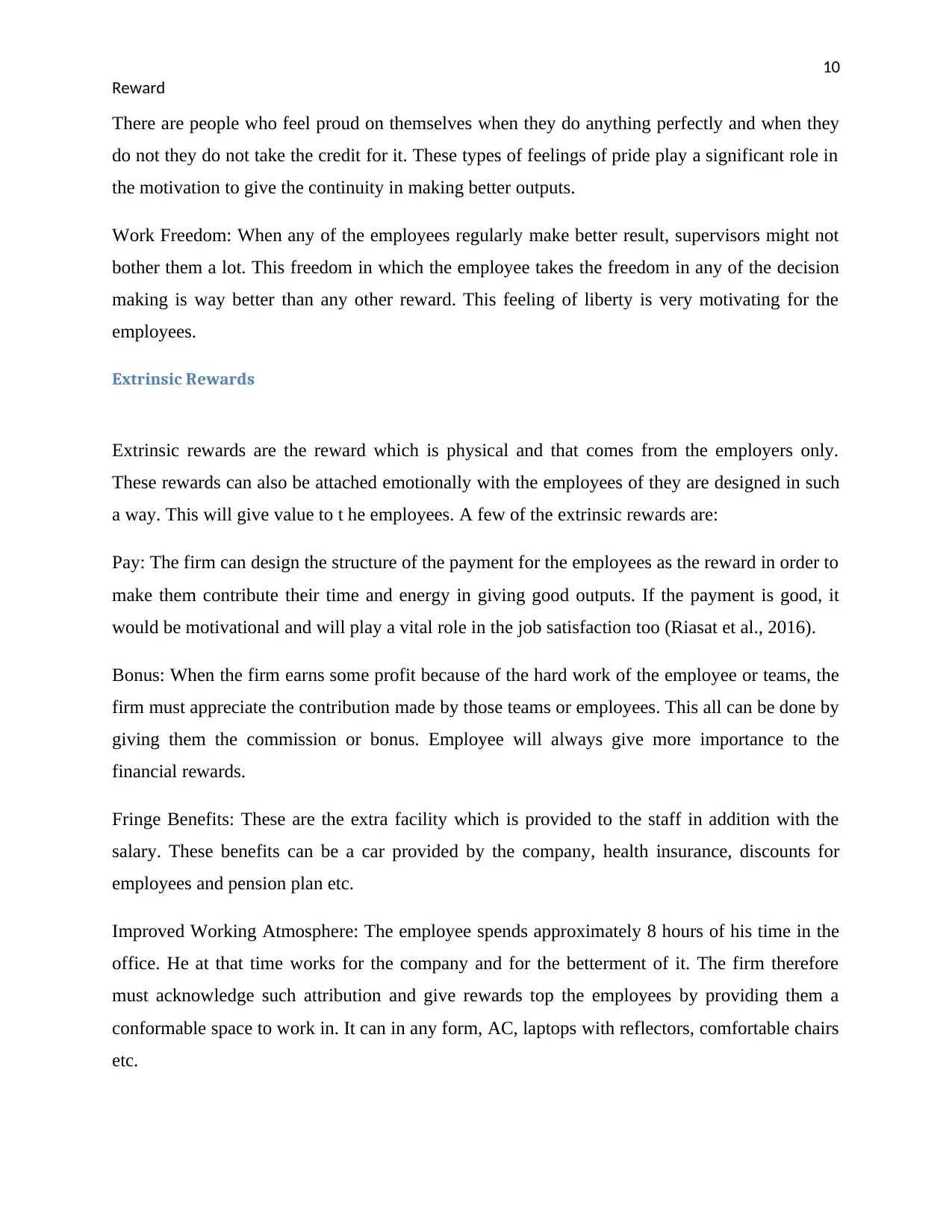
10
Reward
There are people who feel proud on themselves when they do anything perfectly and when they
do not they do not take the credit for it. These types of feelings of pride play a significant role in
the motivation to give the continuity in making better outputs.
Work Freedom: When any of the employees regularly make better result, supervisors might not
bother them a lot. This freedom in which the employee takes the freedom in any of the decision
making is way better than any other reward. This feeling of liberty is very motivating for the
employees.
Extrinsic Rewards
Extrinsic rewards are the reward which is physical and that comes from the employers only.
These rewards can also be attached emotionally with the employees of they are designed in such
a way. This will give value to t he employees. A few of the extrinsic rewards are:
Pay: The firm can design the structure of the payment for the employees as the reward in order to
make them contribute their time and energy in giving good outputs. If the payment is good, it
would be motivational and will play a vital role in the job satisfaction too (Riasat et al., 2016).
Bonus: When the firm earns some profit because of the hard work of the employee or teams, the
firm must appreciate the contribution made by those teams or employees. This all can be done by
giving them the commission or bonus. Employee will always give more importance to the
financial rewards.
Fringe Benefits: These are the extra facility which is provided to the staff in addition with the
salary. These benefits can be a car provided by the company, health insurance, discounts for
employees and pension plan etc.
Improved Working Atmosphere: The employee spends approximately 8 hours of his time in the
office. He at that time works for the company and for the betterment of it. The firm therefore
must acknowledge such attribution and give rewards top the employees by providing them a
conformable space to work in. It can in any form, AC, laptops with reflectors, comfortable chairs
etc.
Reward
There are people who feel proud on themselves when they do anything perfectly and when they
do not they do not take the credit for it. These types of feelings of pride play a significant role in
the motivation to give the continuity in making better outputs.
Work Freedom: When any of the employees regularly make better result, supervisors might not
bother them a lot. This freedom in which the employee takes the freedom in any of the decision
making is way better than any other reward. This feeling of liberty is very motivating for the
employees.
Extrinsic Rewards
Extrinsic rewards are the reward which is physical and that comes from the employers only.
These rewards can also be attached emotionally with the employees of they are designed in such
a way. This will give value to t he employees. A few of the extrinsic rewards are:
Pay: The firm can design the structure of the payment for the employees as the reward in order to
make them contribute their time and energy in giving good outputs. If the payment is good, it
would be motivational and will play a vital role in the job satisfaction too (Riasat et al., 2016).
Bonus: When the firm earns some profit because of the hard work of the employee or teams, the
firm must appreciate the contribution made by those teams or employees. This all can be done by
giving them the commission or bonus. Employee will always give more importance to the
financial rewards.
Fringe Benefits: These are the extra facility which is provided to the staff in addition with the
salary. These benefits can be a car provided by the company, health insurance, discounts for
employees and pension plan etc.
Improved Working Atmosphere: The employee spends approximately 8 hours of his time in the
office. He at that time works for the company and for the betterment of it. The firm therefore
must acknowledge such attribution and give rewards top the employees by providing them a
conformable space to work in. It can in any form, AC, laptops with reflectors, comfortable chairs
etc.
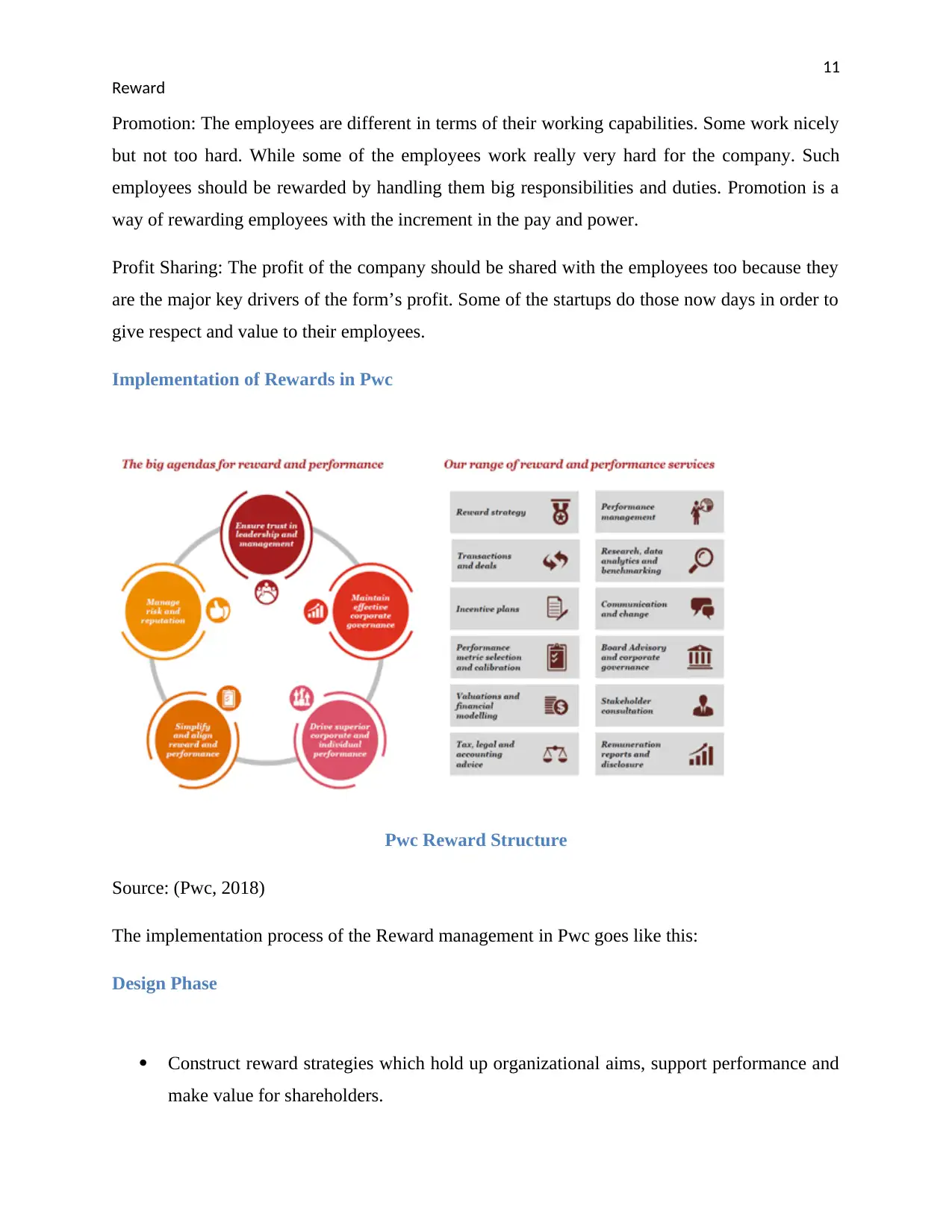
11
Reward
Promotion: The employees are different in terms of their working capabilities. Some work nicely
but not too hard. While some of the employees work really very hard for the company. Such
employees should be rewarded by handling them big responsibilities and duties. Promotion is a
way of rewarding employees with the increment in the pay and power.
Profit Sharing: The profit of the company should be shared with the employees too because they
are the major key drivers of the form’s profit. Some of the startups do those now days in order to
give respect and value to their employees.
Implementation of Rewards in Pwc
Pwc Reward Structure
Source: (Pwc, 2018)
The implementation process of the Reward management in Pwc goes like this:
Design Phase
Construct reward strategies which hold up organizational aims, support performance and
make value for shareholders.
Reward
Promotion: The employees are different in terms of their working capabilities. Some work nicely
but not too hard. While some of the employees work really very hard for the company. Such
employees should be rewarded by handling them big responsibilities and duties. Promotion is a
way of rewarding employees with the increment in the pay and power.
Profit Sharing: The profit of the company should be shared with the employees too because they
are the major key drivers of the form’s profit. Some of the startups do those now days in order to
give respect and value to their employees.
Implementation of Rewards in Pwc
Pwc Reward Structure
Source: (Pwc, 2018)
The implementation process of the Reward management in Pwc goes like this:
Design Phase
Construct reward strategies which hold up organizational aims, support performance and
make value for shareholders.
⊘ This is a preview!⊘
Do you want full access?
Subscribe today to unlock all pages.

Trusted by 1+ million students worldwide
1 out of 19
Related Documents
Your All-in-One AI-Powered Toolkit for Academic Success.
+13062052269
info@desklib.com
Available 24*7 on WhatsApp / Email
![[object Object]](/_next/static/media/star-bottom.7253800d.svg)
Unlock your academic potential
Copyright © 2020–2025 A2Z Services. All Rights Reserved. Developed and managed by ZUCOL.





